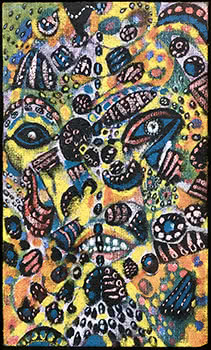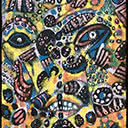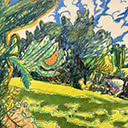Deaths Head - Yellow
47.5 x 28.5 cm
est. $15,000 - 25,000
PROVENANCE
Private Collection, Auckland
Painted in 1970, the year after Philip Clairmont's first solo exhibition, this work invites the viewer to focus on the distillation of the artist's personal meditations and philosophies.
While the painting is not exactly a self-portrait, it's hard to separate it from the idea of a self-portrait. For one thing, we know that Clairmont extensively studied his own image in the mirror. The close-up nature of the head of "death" in this work which has no outlines, no start or finish, suggests that it is looking back at us like a reflection, or perhaps that the artist has been peering closely at himself, conjuring a mirror-like double from the canvas.
The various elements of this painting are a composition of concrete ideas which are deeply intimate and internal to the artist. As Michael Dunn describes it, for Clairmont "obsession with a personal response led to a large number of recognisable self-portraits as well as other images so interwoven with his own life experience that they also are in a way self-portraits". Deaths Head - Yellow is a perfect example of this second type of image: introspection and fragments of thought and emotion are presented in the form of objects and shapes which collectively represent the artist, making it a self-portrait of sorts.
There are some instantly recognisable elements to this work, such as the narrow eyes and dotted-out brow line. These resemble the shape and downwards slant of eyes in his self-portraits. There is also the chaotic confluence of colour and shape found that is typical of Clairmont. Other fragments of evidence emerge from this work, too. In Bruce Morrison and Hamish Keith's 1981 documentary profile of Clairmont, the camera rests briefly on a set of animal teeth as part of a collection of objects in his home. The artist is talking about his "long list of obsessions with studied objects", and his close relationships with these studied objects. The form of these teeth is reflected perfectly in the sharp, animal-like mouth of this work, drawing a direct line from the artist's own home full of found objects, to the eloquent representation of self as a painted object.





